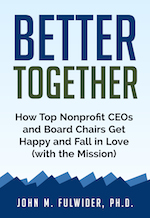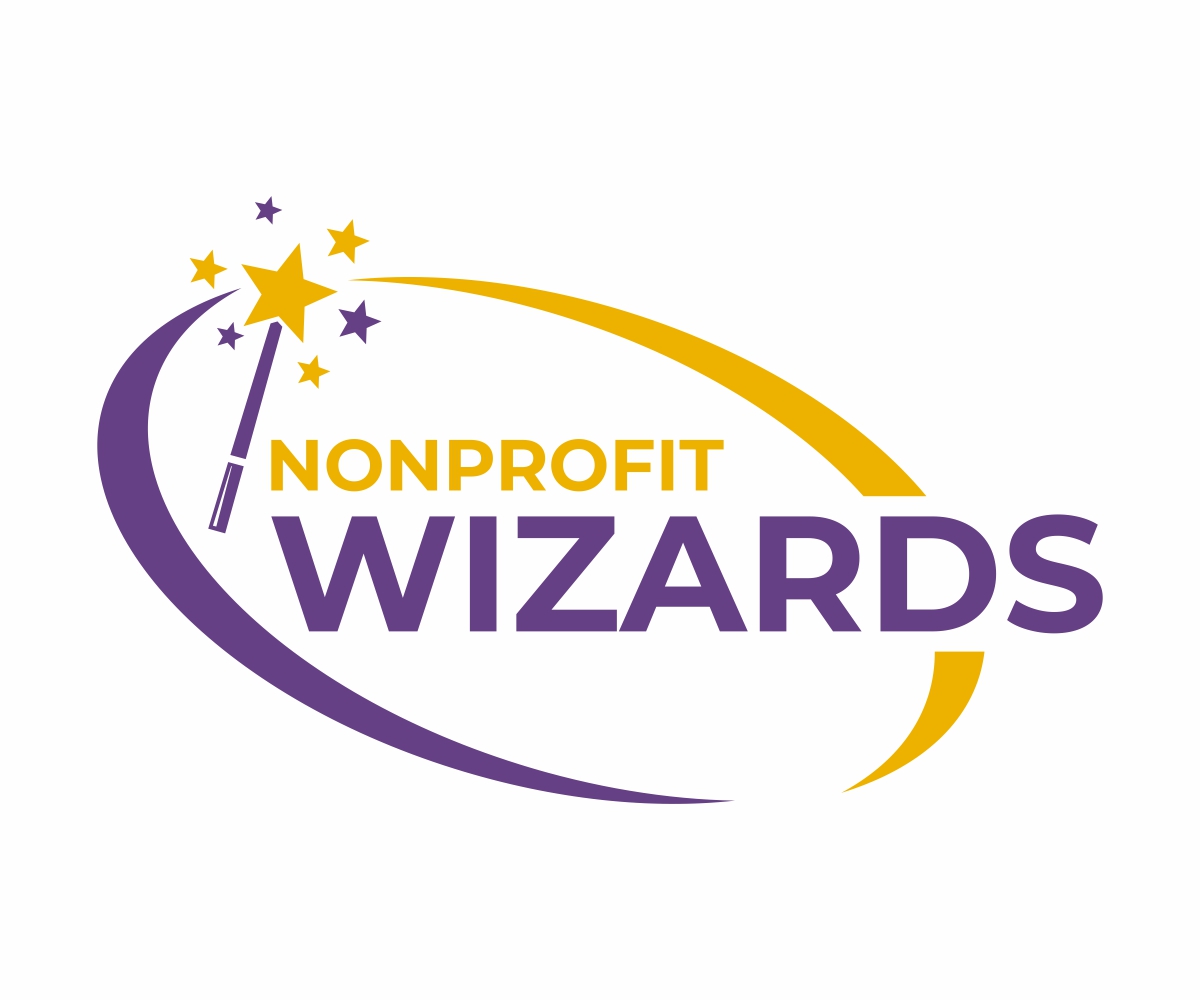Do you wish you could get more from your board?
More help in generating buzz in the community.
More interest in the strategic vision of the organization.
More help with fundraising.
More engagement.
A simple way to get more from your board
The most effective nonprofit organizations in the world have strong boards. It’s no mystery.
What does seem mysterious, however, is how they came to have a strong board.
And how you can get one too.
My colleague John Fulwider decided to discover what that secret sauce is. In his excellent book Better Together How Top Nonprofit CEOs and Board Chairs Get Happy, Fall in Love, and Change Their World, he reveals a common denominator of organizations with strong boards.
Here it is: an executive and board chair who have a great working relationship.
John found that to be the greatest point of leverage for a nonprofit organization.
Don’t worry, I didn’t spoil it for you. There’s still plenty of goodness making this book worth buying. Practical tips, conversation starters, and beautiful stories of success, just to name a few.
My single favorite tip from the whole book: schedule a regular time to speak with your board chair. John recommends once per week.
Once a week, NOT “whenever it is needed”
Generally when I ask an executive about communication with her board chair, I get a version of this:
“We have a great relationship! It’s so casual…we talk whenever we need to.”
I would have told you the same thing ten years ago. It seemed like it worked fine for me and my board chair.
Some weeks we would speak several times. Some weeks would go by where we didn’t speak even once.
It seemed like it worked fine.
Until I tried it the other way.
My interim Executive Director gig
I recently served as interim Executive Director for the LaunchPAD Children’s Museum.
As I began my tenure I suggested to Kyle Kelly, the board chair, that we schedule a weekly check-in.
He agreed. Not enthusiastically, but not reluctantly either.
We reserved Wednesday morning at 9:00 am and set the following rules:
- This time would be sacrosanct.
- The only acceptable excuses to miss were family-related…vacations (which are VERY IMPORTANT), meetings with our kids’ teachers, etc. Or health-related (I had a minor surgery one Wednesday…so I was unconscious). Or if the President of the United States came to visit either of us (no, really…Kyle had a former President visit his office).
- I was responsible for managing the location. Our default option was via phone with me calling him. If I felt like we had an especially complex topic to discuss, we would grab coffee.
- I was also responsible for managing the agenda.
During my engagement, we had five key objectives, not unlike the strategic plan you all should be working from. They were:
- Complete the fundraising campaign.
- Build a building.
- Build and install exhibits.
- Recruit a new director and assist him/her in building a team and developing processes.
- Keep the administrative activities running.
Each week our conversations were framed in terms of progress we’d made in each of those five areas. If it didn’t fit in one of those areas, we didn’t talk about it.
Meetings for meetings’ sake
People often bristle at the suggestion of regular, frequent meetings. They say “we won’t have meetings for meetings sake!” You know, meetings where you could replace yourself with a giant cardboard cut-out and no one would notice.
Some weeks we didn’t have much to talk about. In those cases, we simply acknowledged it at the outset and quickly ended our call.
Other weeks we had more than could fit into 30 minutes. And we extended our time.
Some weeks something extraordinary came up (usually extraordinarily bad, but I was deliberate about working in some surprise good news too) and I would call him on a Monday. Or a Tuesday. Friday even.
“Wait, not long ago you said I shouldn’t talk to my board chair!”
A reader emailed me in response to the loneliness post. According to him, I was “advising people to keep things from his board chair.”
I’m very grateful for the feedback.
And I apologize to anyone else who got the wrong message. That’s a sign of bad writing and it’s on me. I’m still working at this.
To be clear, DO NOT purposely keep things from your board chair.
But, when you are having conversations with him (or her), DO be mindful of the inherent bias he brings to the conversation.
Because he’s the board chair, his primary allegiance is to the organization, not you.
Fortunately, what’s good for the organization and what’s good for you personally are almost always in alignment.
If there is conflict between these two aims, though, make no mistake about where your board chair will land.
It’s his job after all.
Select the correct board chair
One of the reasons our relationship worked well is because Kyle was a good board chair.
I’ve got a list of items to help you screen for a good board chair. Email me and I’ll send it to you.
Some of the items Kyle scored highly on were:
- Analytical and strategic,
- Facilitation skills,
- Respected by other board members, and
- Team player.
I lucked out. Kyle was already the chair when I first got involved.
Here’s an idea for you. Have coffee with your board chair and show her this list. Ask her who among the newer board members she sees scoring well on these items.
This will help you both find your future chair.
Check your ego
Another reason we were successful is that I was willing to let go of my ego.
I realized that in previous board chair relationships, I would sometimes get defensive when asked a lot of questions. And Kyle asked a lot of questions.
I had to continually remind myself it was his obligation to ask questions.
To prod.
To bring things to light.
It didn’t mean he didn’t trust me. It didn’t mean he didn’t recognize and appreciate the job I was doing. He did. He often told me so.
But, by probing and challenging, he was doing his job. He was helping me see things more clearly. He helped identify important issues that I was underestimating.
He was making me better.
And he was making the organization better.
The results
At board meetings, previous chairs I worked with were constantly looking left, to the spot in which I was sitting.
In other words, I did most of the talking.
Now, I actually LIKE talking in front of a crowd. It makes me feel important and valued.
Maybe I’m a bit of a narcissist. Wouldn’t you have to be to write weekly blog posts?
But I digress.
Me talking a lot at board meetings was great for my ego.
But it was terrible for my board chair. It didn’t give him a chance to put his stamp on the organization.
It was terrible for the organization. An executive-dominated nonprofit operates below its potential.
During my interim gig, however, I hardly talked at all.
Kyle led discussions with confidence because he was fully versed in what was going on. Furthermore, he didn’t need to ask me what I thought…because he already knew what I thought.
It was fun to watch.
And very relaxing too, I might add.
What do you think?
Have you made weekly investments in your relationship with your board chair?
I’d love to hear about it! Email me or hop over to the Nonprofit Wizards Facebook page and leave a comment!

Darren Macfee is the founder of the Nonprofit Wizards. He studies the habits and practices of wizards and then shares those with the world. He also strives to be a little better every day–as a husband, as a dad, and as a business professional.


Better Together How Top Nonprofit CEOs and Board Chairs Get Happy, Fall in Love, and Change Their World By John M. Fulwider, Ph.D.
Meditations by
How Full Is Your Bucket? by Tom Rath and Donald O. Clifton, Ph.D.

Thinking Fast And Slow by Daniel Kahneman

The Advantage: Why Organizational Health Trumps Everything Else in Business by Patrick Lencioni

Now, Discover Your Strengths by Marcus Buckingham and Donald O. Clifton
 StrenthsFinder 2.0 by Tom Rath
StrenthsFinder 2.0 by Tom Rath

Good to Great: Why Some Companies Make the Leap…And Others Don’t by Jim Collins

Magnetic: The Art and Science of Engagement by Anne Bergeron and Beth Tuttle

Managing to Change the World: The Nonprofit Manager’s Guide to Getting Results by Alison Green and Jerry Hauser
Any link on this site should be assumed to be an affiliate link. If you’re not sure why you should care click here. You’ll also learn how you can help feed the children.



